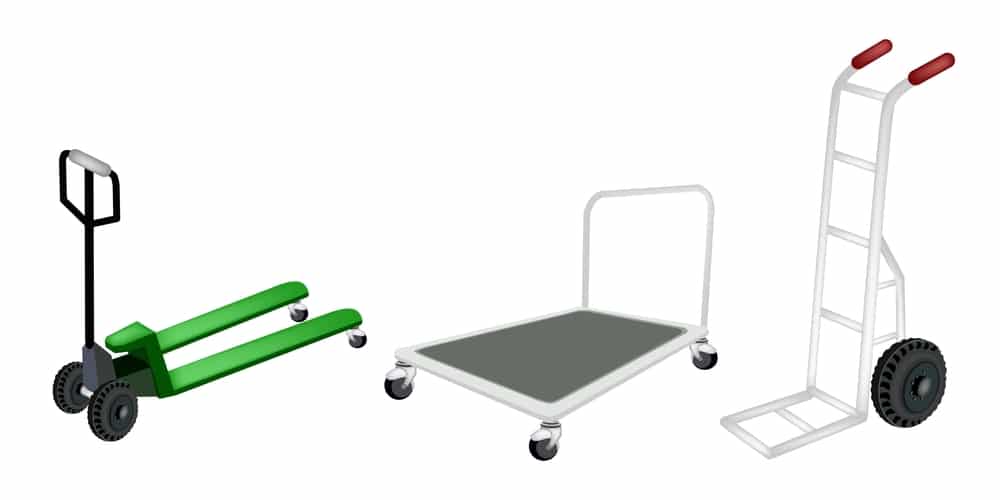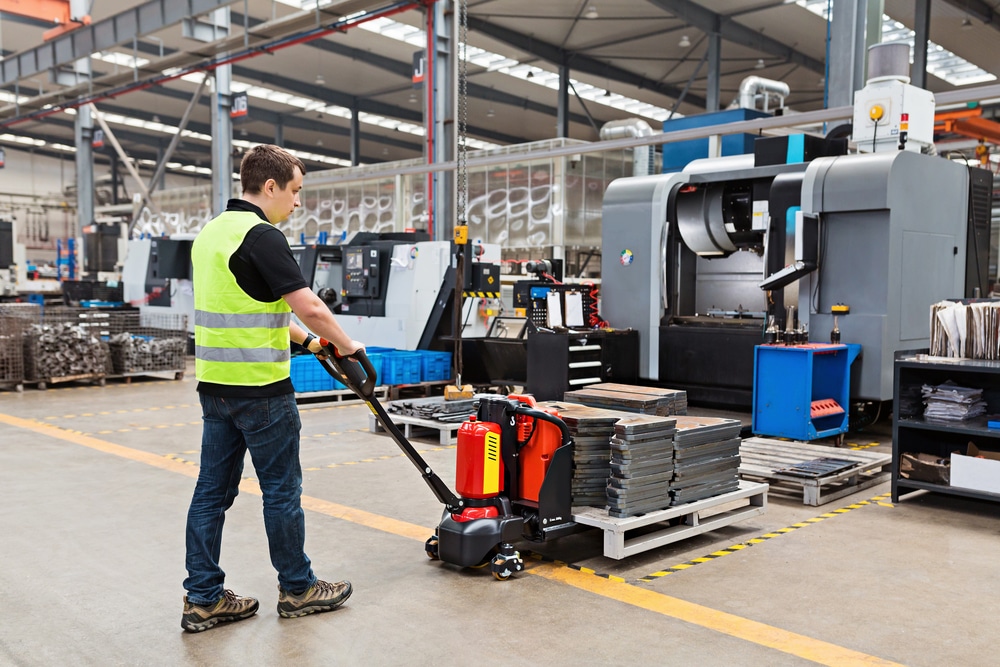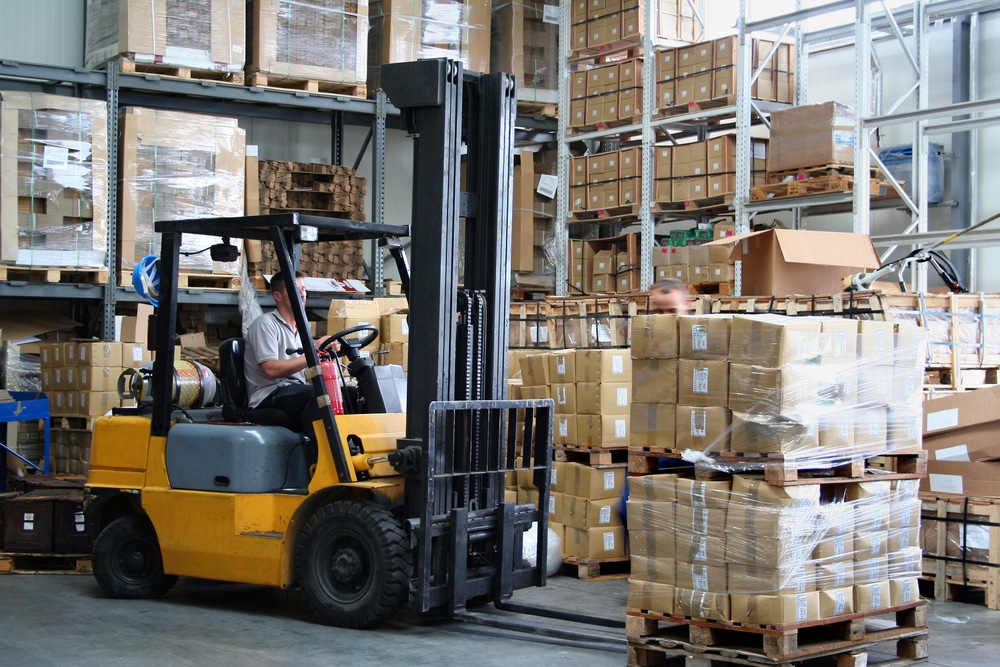Ergonomics in Material Handling

Whether you’re a shop worker or manufacturer, every single day, you’re interacting with materials of varying shapes, sizes, and weights, whether it’s at your workplace or even within your own home.
Yet, how often do you stop to consider the impact of these actions on your whole body?
How you handle these materials can significantly affect your well-being, productivity, and long-term health. In this blog post, we’ll delve into the science behind ergonomics, exploring the crucial interplay between the human body and the objects we lift, carry, and manipulate.
From proper lifting techniques and equipment utilization to pointing out common ergonomic hazards that can lead to health complications down the line, this guide is your roadmap to a safer, more mindful approach to material handling and ergonomic principles in the workplace.
You might also want to check out our employee Material Handling Training product as well.
Material Handling Ergonomics: Understanding the Basics
Ergonomics, often called the science of fitting work to people’s comfort, lies at the heart of a harmonious relationship between humans and their work environment.
Material handling involves designing and encouraging tasks, tools, and work habits that accommodate the human body’s natural abilities and limitations. Doing so can reduce the risk of injured employees, enhance their productivity, and promote overall well-being.

The Impact on Employee Health and Efficiency
The link between ergonomics and the health of employees is undeniable.
Poorly designed material handling processes can lead to strains, sprains, and repetitive stress injuries, resulting in discomfort, pain, and prolonged absenteeism. Talking to employees about materials handling best practices is a win-win for your company.
Moreover, disregarding ergonomic fundamentals can hinder efficiency as workers struggle to navigate awkward postures whilst lifting heavy objects, hampering their performance.
Benefits of Incorporating Ergonomics in the Workplace
Injury Prevention
Prioritizing ergonomics minimizes the likelihood of injuries caused by improper lifting, carrying, or pushing. This translates to reduced workers’ compensation claims and medical costs.
Enhanced Productivity
Ergonomically designed workspaces and equipment facilitate smoother workflows, allowing employees to perform tasks more efficiently and comfortably.
Boosted Workplace Morale
Job satisfaction increases when employees feel that their well-being is valued, thanks to the consistent promotion of ergonomic work habits. This leads to higher morale, better engagement, and decreased turnover rates.
Improved Long-Term Health
Implementing ergonomic practices fosters a healthier work environment, which can positively impact the long-term health of employees, reducing chronic conditions related to poor posture and repetitive movements.

Common Risk Factors & Ergonomic Hazards
Awkward Posture
Maintaining comfortable body positions during material handling tasks is fundamental to workplace ergonomics.
Awkward postures and movements, such as bending, twisting, or reaching unnaturally, can strain muscles and joints, increasing the risk of injury and cumulative trauma disorders. These positions disrupt the body’s natural alignment, leading to discomfort and potential long-term damage.
To mitigate these risk factors, keep the spine in a neutral position and avoid twisting and bending excessively. Use appropriate equipment, whenever necessary, to avoid back injuries.
Applying Excessive Force
Overexerting yourself by applying too much force during material handling tasks can lead to muscle strains, sprains, and soft tissue injury. Pushing, pulling, or lifting objects that are too heavy or where the force required to move them is significant can put undue (and unnecessary) stress on your body.
To prevent this hazard, know your limits and use mechanical handling equipment whenever feasible. Proper training in lifting techniques (which we’ll get into later), along with a focus on maintaining proper posture and distributing the load evenly, can help reduce the risk of injury caused by applying excessive force.
Remember: working smarter, not harder, is key to maintaining your well-being.

Prolonged Activities
Engaging in repetitive tasks for long periods of time can take a massive toll on your body. Repetitive actions without breaks (such as general computer work) can lead to injuries such as muscle fatigue, strain, and even chronic ailments.
To counter risk factors like these, integrate regular pauses and stretches into your routine, keep essentials within easy reach if operating from a desk, and vary your daily tasks when possible to avoid continuous strain on the same muscles.
Giving your body a chance to rest and recover will reduce the risk of injury and enhance your overall productivity and well-being.
Consider improvements to your work area, such as a desk with an adjustable height as well.
Repetitive Motion Injuries
Performing the same motions repeatedly during material handling can lead to what is known as a repetitive motion injury; work tasks like twisting, gripping, or carrying objects can cause untenable physical strain in the muscles and tendons.
To combat this hazard, introduce task rotation or increase the number of employees involved in the job to diversify movements and reduce strain on specific body parts.
Regular stretches targeting the different muscle groups involved can also alleviate tension; pay attention to early signs of cumulative trauma disorders, and don’t hesitate to seek guidance.

Constant Mechanical Stress
Continuous exposure to mechanical vibrations, such as those from operating heavy machinery or hand tools, can lead to discomfort and health issues. Prolonged exposure to vibrations can affect blood vessels and nerve function and even cause musculoskeletal disorders.
To mitigate this risk factor, ask your employer to provide anti-vibration gloves and tools with ergonomic handles to ensure you’re not applying too much pressure on your body.
Proper Lifting Techniques
Feet First
When performing heavy lifting, always prioritize moving your feet first. This technique brings you closer to the load, minimizing the need for excessive reaching. By reducing the distance you have to reach and keeping your load close, you decrease the strain on both your upper body and the load itself.
Moreover, this approach minimizes the risk of twisting or bending your body while lifting (thus reducing the risk of a back injury), promoting a safer and more effective lifting motion.
Building a Bridge
When carrying loads, your upper body position almost always determines the strain involved.
For starters, be sure to avoid the risky one-sided bridge posture – bending at the waist and leaving your upper back completely unsupported. This concentrates stress on your lower back, escalating injury risk on the job.
Instead, try building a bridge for support. Place an arm on your leg or a stable object while lifting heavy items. For heavier loads needing both arms, step forward with one leg, creating a “bridge” with your legs; this redistributes the load, further reducing your back’s strain.

The “Deadlift” Stance
As you lift a heavy item off the ground, be sure to control it by employing an almost deadlift-like stance. By keeping the load within your power zone, you maintain the natural curves of your back, as this positioning maximizes the strength and support provided by your vertebrae, discs, ligaments, and muscles.
The “Deadlift” stance not only empowers you to lift more efficiently but also helps preserve the integrity and overall health of your spine, as it enables you to avoid twisting or bending.
Staggered Stance
To prevent injuries on the job when lifting heavy loads, avoid having your feet close together and in line with each other; instead, adopt a staggered stance.
This positioning encourages your legs to contribute to the lift actively, lessening the strain on your back. Stepping toward the load with a staggered stance shifts your center of gravity nearer to the load, reducing the effort required.
If you sense your weight shifting forward onto your leading leg, you’ve successfully shifted the weight demand from your back to your stronger legs.
Use Material Handling Equipment Whenever Possible
When faced with heavy or bulky loads that are simply too much to handle, utilizing material handling equipment will always be the smartest choice.
Dollies, carts, and forklifts are designed to assist in moving objects safely and efficiently, minimizing the strain on your muscles and tendons. These tools reduce the need for excessive lifting and carrying, helping you avoid unnecessary physical stress on the job.
Final Thoughts
As we conclude our journey through the fundamentals of ergonomics in material handling, one thing remains clear: the well-being of employees involved in material handling tasks is a priority that cannot be overlooked. A safer and more efficient work area is not an elusive goal but an achievable reality through the proper implementation of fundamentals.
Remember, injury prevention and safety is not a one-time effort but an ongoing commitment. By incorporating ergonomic elements and practices into your daily routines and collaborating with your team to identify and mitigate risks, you contribute to a healthier, more resilient work environment.
Frequently Asked Questions
What does OSHA say about ergonomics?
The Occupational Safety and Health Administration (OSHA) encourages all employers to keep the workplace safe (and their employees safe) of all possible ergonomic hazards that could arise in a given work area. They also carry out training to ensure the employee performs every task with proper ergonomics.
What are ergonomic materials?
Ergonomic materials refer to substances or components that are designed and selected with the principles of ergonomics in mind. These materials are chosen to enhance comfort, reduce strain, and promote better interactions between employees and their environment, encouraging overall safety and health.
These materials are often used in the construction of furniture, tools, equipment, and workspaces to create environments that prevent injuries, discomfort, and long-term health issues.
What are common material handling injuries?
Here’s a list of common material handling injuries that occur when a workspace doesn’t have proper ergonomics:
- Strains and Sprains
- Muscle Fatigue
- Repetitive Strain Injuries
- Hernias
- Fractures
- Tennis Elbow
- Chemical Exposure
- Shoulder Pain
- Slips, Trips, and Falls